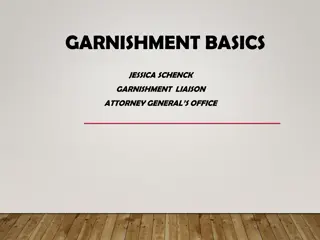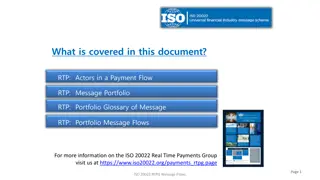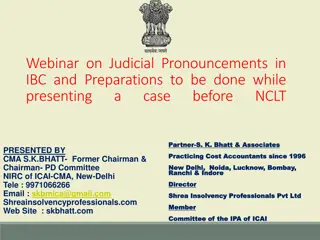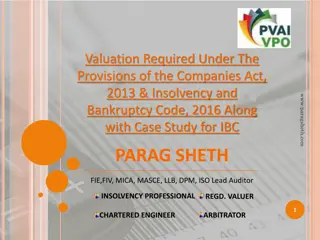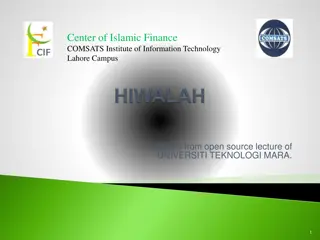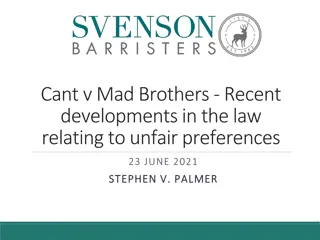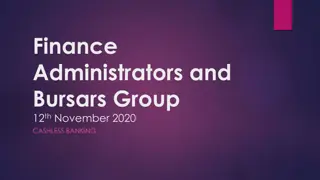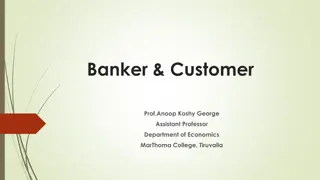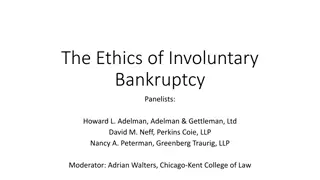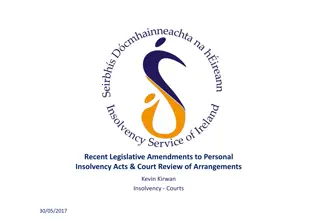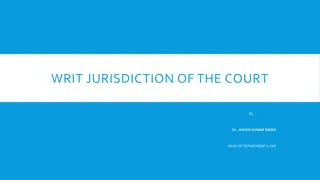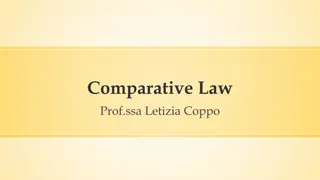Factors Influencing Working Capital Management
Factors influencing working capital include the nature and size of the business, demand of creditors, cash requirements, time for manufacturing goods, volume of sales, terms of purchases and sales, and the business cycle. The nature of the company, creditor demands for security, cash needs, and the
0 views • 7 slides
Interpretation of Statutes and Articles: Taxation, Corporate Laws, Writ Remedies
Understanding the interpretation of statutes, articles of the Indian Constitution in relation to taxation, corporate laws for practicing members, and utilizing writ remedies before the High Court and Supreme Court. Exploring the scope of writs for enforcing fundamental rights, constitutional rights,
10 views • 38 slides
Understanding Termination of Obligations in Civil Law
Termination of obligations can occur voluntarily through legal agreements or involuntarily through factual occurrences. There are two main types of termination: by the will of the parties (such as legal transactions) and independently of the parties' will (due to certain legal facts). The cessation
3 views • 25 slides
About page
About AEGLE MARMELOS Law Firm:\n\u2022 Dedication to Legal Excellence: . Aegle Marmelos is committed to providing top-tier services in Criminal, Writs, Family, Civil, and Company Law, ensuring robust courtroom representation for our clients\n\u2022 Inspiration from the Bael Fruit: Our firm's name,
1 views • 4 slides
Garnishment Basics and Process Overview
Understanding garnishment basics and the process involved in handling creditor writs, timelines, proper service requirements, and the role of the Attorney General's Office. Learn about the types of creditor writs, filing requirements, and how the garnishee is named, along with details on different 6
1 views • 34 slides
Understanding Debentures and Charges in Company Law
Debentures play a significant role in company law, representing various types of securities issued by a company. They are defined under the Companies Act and have specific characteristics, such as being under common seal, repayment terms, interest payments, and charges on movable property. Debenture
0 views • 21 slides
Real-Time Payments: Actors and Message Flows Overview
This document provides an overview of the actors involved in a payment flow and the message portfolio in Real-Time Payments (RTP). It includes details on various actors like Instructing agent, Forwarding agent, Ultimate Debtor, Reimbursement agents, and more. The provided message flows illustrate th
1 views • 12 slides
Understanding Ratio Analysis in Financial Statements
Ratio analysis is a crucial process in interpreting financial statements by deriving accounting ratios from the balance sheet and profit and loss account. It involves assessing short-term liquidity, long-term solvency, activity ratios, and profitability ratios. Liquidity ratios like current ratio, q
2 views • 41 slides
Understanding the Banker-Customer Relationship
The relationship between a banker and a customer is defined by the provision of banking services such as fund transfers and cheque issuance. It is primarily a debtor-creditor relationship but also involves trust, agency, bailment, mortgage, and leasing aspects. Regulations are governed by laws like
0 views • 14 slides
Understanding Banking Relationships and Responsibilities
Explore the intricate relationships and responsibilities in banking, from the roles of bankers as debt creators to customers as buyers of services. Learn about debtor-creditor relations, creditor-debtor relationships, and the dynamics of beneficiary-trustee interactions in the banking sector.
2 views • 11 slides
Understanding Garnishee Orders in Civil Procedure Code
A Garnishee Order, issued under Order 21, Rule 46 of the Code of Civil Procedure, allows a court to direct a third party (garnishee) holding the debtor's assets to pay the creditor directly. This article explains the concept, process, and implications of Garnishee Orders in debt recovery procedures
0 views • 18 slides
Webinar on Judicial Pronouncements in IBC and NCLT Case Presentation
This webinar covers judicial pronouncements in Insolvency and Bankruptcy Code (IBC) cases and essential preparations for presenting a case before the National Company Law Tribunal (NCLT). It includes insights and case discussions regarding debt assignment, related party transactions, and disputes ov
0 views • 37 slides
Overview of Valuation Requirements under Companies Act, 2013 & IBC 2016
This text provides insights into the valuation requirements stipulated by the Companies Act, 2013 and the Insolvency and Bankruptcy Code, 2016. It includes sections demanding valuation reports from registered valuers, such as for share capital issues, audit committee terms, director transactions, cr
0 views • 54 slides
Understanding Hiwalah: Debt Transfer in Islamic Finance
Hiwalah is a form of debt transfer in Islamic finance where a debtor transfers their debt to another party. This process relieves the original debtor of financial obligations, with the creditor able to demand repayment from the new debtor. The legality and process of Hiwalah, along with the Prophet
0 views • 17 slides
Working Capital and Current Ratio in Accounting
Understanding indicators like net current assets (working capital) and current ratio is crucial in accounting. Net current assets reflect the ability to settle current liabilities and the capital required for operational functions. Managing working capital effectively involves factors like stock man
0 views • 12 slides
Recent Developments in Unfair Preferences Law
The law on unfair preferences, particularly under Section 588FA of the Corporations Act, addresses transactions where a company favors a creditor, resulting in the creditor receiving more than they would in a winding up process. Recent cases like Cant v. Mad Brothers and Re Emanuel highlight the com
0 views • 27 slides
Benefits and Process of Cashless Banking in Schools
Explore the advantages of cashless banking in educational institutions, including enhanced security, cost savings, and quicker transactions. Learn about electronic payments like BACS and CHAPS, how to set them up, process BACS payments, and considerations for BACS transactions. Discover the importan
0 views • 11 slides
Dealing with IRS Assessments: Options for Challenging Unfair Tax Claims
Learn how to address erroneous IRS assessments through various options like audit reconsideration, doubt-as-to-liability, offers in compromise, refund litigation, and bankruptcy. Make an informed choice based on factors like refund eligibility, ability to pay, receipt of the Notice of Deficiency, an
0 views • 5 slides
Understanding the Relationship Between Banker and Customer
Exploring the dynamics of the relationship between a banker and a customer, including definitions, types of relationships, features, and the roles of debtor/creditor, bailee/bailor, and trustee/beneficiary in the banking context.
0 views • 42 slides
Ethical Considerations in Involuntary Bankruptcy Cases
This content discusses three scenarios involving ethical dilemmas in the context of involuntary bankruptcy filings. From managers filing against fellow LLC members to lenders initiating bankruptcies for strategic reasons, the scenarios highlight complex issues such as creditor solicitation, usury de
0 views • 6 slides
Recent Legislative Amendments to Personal Insolvency Acts & Court Review of Arrangements
The recent legislative amendments to the Personal Insolvency Acts introduced new provisions for court reviews of arrangement proposals, including changes to eligibility thresholds for Debt Relief Notices (DRNs) and increased regulation of Personal Insolvency Practitioners (PIPs). The Court Review un
0 views • 41 slides
Asset Protection Strategies for Families: Tips and Insights by Daniel Timins, Esq.
Learn about important asset protection strategies for families, including safeguarding assets from creditors, understanding the protection of Social Security benefits, navigating retirement plan implications in divorce cases, preventing fraudulent conveyances, and identifying creditor protections in
0 views • 14 slides
Understanding Writ Jurisdiction of the Court: Key Concepts and Types Explained
Explore the jurisdiction of the court in the issuance of writs, including the general meaning of writs, constitutional remedies under the Indian Constitution, types of writs such as Habeas Corpus, Mandamus, Prohibition, Certiorari, and Quo-warranto, with detailed explanations and case references.
0 views • 10 slides
Evolution of English Law: Historical Origins and Formation
The historical origins and formation of English law trace back to the Medieval period, characterized by Norman conquest, feudalism, and a strong central royal authority. The organization of the judiciary system and the development of procedural rules played pivotal roles in shaping English law. The
0 views • 30 slides




